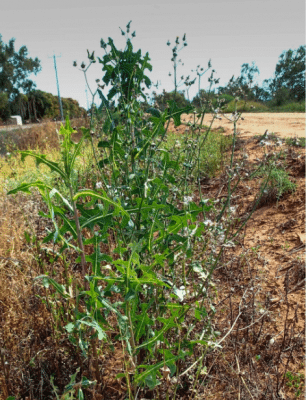Two populations of the broadleaf weed, willow-leaved lettuce (Lactuca saligna) have been confirmed to be resistant to the key herbicide, glyphosate, in vegetable production in Western Australia.

Caption: Willow-leaved or wild lettuce (Lactuca saligna) on a channel bank with sowthistle (Sonchus oleraceus), Carnarvon, WA. Photo: John Stretch, DPIRD
Willow-leaved lettuce, also known as wild lettuce, has increased in abundance during the past 10 years, due to a widespread shift in the industry to glyphosate-based weed control.
The resistance was confirmed in a commercial horticulture crop in the Gascoyne irrigation area.
Western Australian Department of Primary Industries and Regional Development (DPIRD) principal research officer Abul Hashem, a member of the Australian Glyphosate Sustainability Working Group, said the discovery was of immediate concern to the irrigated agriculture industry but was also relevant to other sectors including the grains industry.
“This is another unwanted world-first for Australia and is the seventh glyphosate resistant broadleaf weed species to be confirmed in Australia,” Dr Hashem said.
Willow-leaved lettuce, an annual-to-biennial, warm season weed found in disturbed areas, roadsides, channel banks, fence lines and horticultural crops, is from the daisy (Asteraceae) family. It has the potential to move into cropping paddocks due to its wind-blown seed.
“Willow-leaved lettuce joins its close relative, prickly lettuce, populations of which were confirmed to be resistant to glyphosate in 2014.”
“While the actual level of glyphosate resistance is quite low, at double that of susceptible populations, experience with sowthistle (Sonchus oleraceus) in New South Wales shows low level glyphosate resistance is enough to result in significant increases in weed numbers in paddocks being treated with glyphosate alone,” Dr Hashem said.
“The discovery of glyphosate resistant willow-leaved lettuce in vegetable production shows that no sector of agriculture is immune to glyphosate resistance, if glyphosate is the main weed control strategy.
“The mature seed can be dispersed by wind over a long distance so the resistant gene could spread into cropping paddocks and establish within a short period of time when glyphosate fails to control this weed.
Management strategies to reduce the risk of herbicide resistance in willow-leaved lettuce include using robust rates of glyphosate, improving spray application techniques, double knocking with another herbicide with a different mode of action or cultivation and using robust tank-mixes with both herbicides effective on the target species.
“Growers need to be on the look-out for weeds surviving herbicide applications and stop them from setting fertile seed.”
The Australian Glyphosate Sustainability Working Group is supported by the Grains Research and Development Corporation and key research and development based crop protection companies, with an interest in the sustainability of glyphosate. The group has a range of information about glyphosate resistance, including a register of glyphosate resistant weed populations and guides and links to details about the management of glyphosate resistance in different crops and management situations on its website.
Source: WA Department of Primary Industries and Regional Development



HAVE YOUR SAY